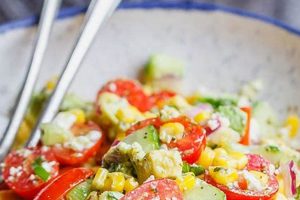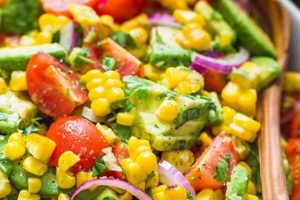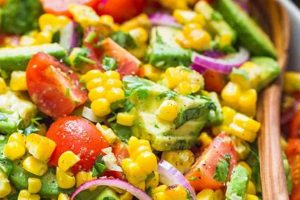Dishes featuring maize kernels preserved through canning as a primary ingredient offer a convenient and affordable foundation for diverse salads. These salads can range from simple combinations of corn, other vegetables, and a basic vinaigrette to more complex creations incorporating proteins, cheeses, herbs, and spices. For instance, a straightforward version might combine canned corn with diced red onion, chopped bell pepper, and a light lemon-herb dressing.
The utilization of canned corn offers advantages in terms of accessibility and ease of preparation, making these salads suitable for year-round consumption regardless of fresh corn availability. This preservation method retains much of the corn’s nutritional value, offering a source of fiber and certain vitamins. Historically, preserving corn through canning played a significant role in extending access to this staple food beyond harvest seasons, impacting culinary traditions and dietary habits across cultures. The adaptability of canned corn allows for diverse flavor profiles and textures in salads, catering to a broad range of palates.
The following sections will explore various aspects of creating these versatile salads, including ingredient selection, preparation techniques, dressing options, and suggested pairings for a complete meal.
Tips for Canned Corn Salads
Maximizing the potential of canned corn salads involves attention to several key elements. These tips offer guidance on enhancing flavor, texture, and overall appeal.
Tip 1: Rinse the Corn: Rinsing canned corn under cold water removes excess starch and sodium, contributing to a fresher, cleaner flavor profile.
Tip 2: Balance Textures: Incorporate ingredients that provide textural contrast. Crisp vegetables like bell peppers or celery complement the softness of the corn, while nuts or seeds add a satisfying crunch.
Tip 3: Explore Flavor Combinations: Consider complementary flavors. Southwest-inspired salads might include black beans, cilantro, and lime juice, while a Mediterranean approach could incorporate feta cheese, olives, and oregano.
Tip 4: Dress Strategically: Avoid overly heavy dressings that can mask the corn’s flavor. Light vinaigrettes, creamy dressings used sparingly, or even a simple squeeze of citrus juice can suffice. Dress the salad just before serving to prevent it from becoming soggy.
Tip 5: Consider Temperature: While often served chilled, canned corn salads can also be enjoyed at room temperature or even slightly warmed, particularly those featuring roasted vegetables or grilled proteins.
Tip 6: Elevate with Herbs and Spices: Fresh herbs like parsley, cilantro, or chives add brightness and depth. Spices such as chili powder, cumin, or paprika can introduce a welcome complexity.
Tip 7: Don’t Overcrowd the Bowl: Allow space for the individual ingredients to shine. A balanced combination of flavors and textures, not sheer quantity, contributes to a successful salad.
By employing these tips, one can transform simple canned corn into satisfying and flavorful salads suitable for a wide range of occasions.
The following section will offer a selection of recipes to demonstrate these principles in practice.
1. Ingredient Combinations
Ingredient combinations significantly influence the flavor profile, nutritional value, and overall appeal of canned corn salads. Careful selection creates synergistic relationships between components, transforming simple ingredients into a cohesive and satisfying dish. The interplay of sweet corn with other elements offers a versatile canvas for culinary exploration. For instance, acidic ingredients like tomatoes or lime juice cut through the corn’s sweetness, while creamy additions like avocado or feta cheese provide richness and textural contrast. The inclusion of proteins such as black beans, grilled chicken, or shrimp elevates the salad from a side dish to a complete meal. Leafy greens contribute vitamins and minerals, while crunchy components like bell peppers, red onion, or toasted nuts offer textural complexity.
The success of a canned corn salad relies heavily on the balance and harmony of its ingredients. Combining contrasting flavors and textures creates a more dynamic and engaging sensory experience. A salad featuring corn, black beans, red onion, bell pepper, and a cilantro-lime dressing exemplifies this principle, offering a vibrant combination of sweet, savory, acidic, and herbaceous notes. Furthermore, the choice of ingredients impacts the nutritional profile of the salad. Incorporating a variety of vegetables, lean proteins, and healthy fats enhances the dish’s nutritional value, providing a source of fiber, vitamins, minerals, and essential fatty acids.
Understanding the role of ingredient combinations allows for informed choices that align with dietary preferences and desired flavor profiles. Considerations extend beyond individual ingredient characteristics to their collective impact on the final product. This understanding allows for both adherence to established recipes and creative experimentation, ultimately leading to more enjoyable and nutritious canned corn salads.
2. Texture Variety
Texture plays a crucial role in the overall enjoyment of canned corn salad recipes. A successful salad engages the palate with a variety of textures, preventing monotony and enhancing the sensory experience. The inherent sweetness and relatively soft texture of canned corn provide a foundation upon which contrasting textures can build, creating a more dynamic and satisfying dish.
- Crunchy Elements
Crunchy elements provide a stark contrast to the soft corn kernels. Common examples include chopped raw vegetables such as bell peppers, celery, or red onion. Toasted nuts, seeds, or croutons offer additional options, introducing both textural variation and complementary flavors. The interplay of soft and crunchy textures creates a more engaging mouthfeel.
- Creamy Components
Creamy components introduce a different type of textural contrast, adding richness and a smooth mouthfeel. Avocado, crumbled cheeses like feta or cotija, or a dollop of Greek yogurt or sour cream contribute creaminess. These elements balance the potentially simpler textures of corn and other vegetables, enhancing the overall complexity of the salad.
- Chewy Additions
Introducing chewy textures can further diversify the salad’s profile. Dried fruits like cranberries or raisins, cooked grains like quinoa or barley, or even cooked beans provide chewiness. These ingredients add another layer of textural interest, complementing the existing crunchy and creamy elements.
- Firm Ingredients
Firmer ingredients provide a substantial bite, anchoring the salad and adding structural integrity. Examples include blanched or roasted vegetables like broccoli, green beans, or asparagus. Grilled or pan-fried tofu or tempeh can also contribute a firm texture while boosting the protein content. These elements create a more satisfying and complete meal experience.
The strategic combination of these textural elements elevates canned corn salads beyond simple mixtures. A well-balanced salad offers a dynamic interplay of textures, ensuring a more engaging and enjoyable culinary experience. By considering the textural contributions of each ingredient, one can craft a salad that is not only flavorful but also texturally stimulating.
3. Flavor Profiles
Flavor profiles significantly influence the overall enjoyment and versatility of canned corn salad recipes. Understanding the interplay of different taste components allows for the creation of well-balanced and nuanced salads that cater to a variety of palates. The inherent sweetness of canned corn provides a versatile base upon which a spectrum of flavor profiles can be built, ranging from bright and tangy to savory and smoky.
- Sweet and Savory
This classic combination balances the corn’s natural sweetness with savory elements. Ingredients like bacon, ham, or grilled chicken contribute savory notes, while a touch of maple syrup or honey can enhance the sweetness. A vinaigrette with a balance of acidity and sweetness further complements this profile. This balance creates a harmonious flavor experience, appealing to a broad range of tastes.
- Spicy and Tangy
This profile introduces a kick of heat balanced by bright acidity. Jalapeos, chipotle peppers, or a dash of cayenne pepper provide the spice, while lime juice, vinegar, or pickled onions offer tanginess. This combination delivers a vibrant and refreshing salad, particularly suitable for warmer weather. Cilantro or other fresh herbs can further enhance the complexity of this flavor profile.
- Earthy and Herbaceous
This profile emphasizes earthy notes and fresh herbs. Ingredients like mushrooms, roasted root vegetables, or black beans contribute earthy flavors, while fresh herbs like parsley, dill, or oregano provide a bright, herbaceous counterpoint. A lemon-herb vinaigrette or a simple olive oil and vinegar dressing complements these flavors without overpowering them. This combination offers a sophisticated and nuanced salad experience.
- Smoky and Tangy
Smoked paprika, chipotle powder, or grilled corn kernels introduce smoky notes, while ingredients like lime juice, apple cider vinegar, or crumbled goat cheese provide tanginess. This flavor profile offers a unique depth and complexity. The interplay of smoky and tangy flavors creates a memorable and satisfying culinary experience.
By understanding these flavor profiles and the ingredients that contribute to them, one can create canned corn salads tailored to specific preferences and occasions. The versatility of canned corn allows for endless flavor combinations, making it a staple ingredient for a wide range of salads.
4. Dressing Choices
Dressing choices profoundly impact the overall flavor profile and enjoyment of canned corn salads. The dressing acts as a unifying element, binding the individual ingredients together and contributing essential flavor notes. Careful consideration of the dressing’s acidity, sweetness, creaminess, and overall flavor intensity ensures it complements rather than overwhelms the delicate sweetness of the corn and other salad components. A heavy, creamy dressing might mask the other flavors, while an overly acidic dressing could clash with the corn’s sweetness. For instance, a light vinaigrette with a citrus base complements a salad with fresh herbs and vegetables, while a creamy cilantro-lime dressing enhances a Southwestern-inspired salad with black beans and avocado.
The interplay between the dressing and the other ingredients creates a synergistic effect. The dressing should enhance the existing flavors and textures, not compete with them. A salad featuring grilled corn, charred peppers, and smoky spices benefits from a similarly smoky and slightly sweet dressing, while a salad with fresh herbs and crisp vegetables might pair well with a light vinaigrette featuring lemon juice or white wine vinegar. Understanding these relationships allows for informed choices that elevate the salad from a simple combination of ingredients to a cohesive and flavorful dish. Furthermore, the choice of dressing can also influence the nutritional profile of the salad. Opting for a vinaigrette over a creamy dressing generally reduces the calorie and fat content while increasing the presence of healthy fats from oils like olive or avocado oil.
Successfully navigating dressing choices requires an understanding of flavor pairings and balance. The dressing should harmonize with the other ingredients, creating a cohesive and enjoyable culinary experience. Considering factors such as acidity, sweetness, creaminess, and the intensity of added flavors like herbs and spices ensures the dressing complements the salad’s overall composition. This understanding enables informed decision-making, transforming canned corn salads into flavorful and well-balanced meals.
5. Preparation Methods
Preparation methods significantly influence the final outcome of canned corn salad recipes. While the convenience of canned corn simplifies the process, attention to specific techniques enhances flavor, texture, and overall appeal. These methods encompass ingredient handling, combining elements, and timing considerations, each contributing to the salad’s success.
- Draining and Rinsing
Draining excess liquid from the can is essential to prevent a watery salad. Rinsing the corn further removes residual starch and sodium, contributing to a cleaner flavor profile and preventing the salad from becoming overly sweet or salty. This step, while seemingly simple, significantly impacts the final taste and texture.
- Ingredient Preparation
Proper ingredient preparation ensures optimal flavor and texture combinations. Uniformly chopping vegetables promotes even distribution and consistent bite. Dicing ingredients too large or small can create imbalances in texture and flavor distribution. If incorporating other cooked vegetables or proteins, ensuring they are properly cooled before combining them with the corn prevents the salad from becoming warm and wilted.
- Combining Ingredients
The order in which ingredients are combined can influence the final result. Generally, more delicate ingredients, such as fresh herbs or leafy greens, should be added last to prevent bruising or wilting. Gently tossing the salad ensures even distribution of the dressing and prevents damage to delicate components. Overmixing can lead to a less appealing presentation and potentially compromise the texture of certain ingredients.
- Dressing Application
The timing of dressing application impacts the salad’s freshness and texture. Adding the dressing too early can cause delicate ingredients to wilt and become soggy. Ideally, the dressing should be added just before serving. This preserves the crispness of vegetables and prevents the salad from becoming watery. For make-ahead salads, storing the dressing separately and adding it just before serving maintains optimal texture and flavor.
Proper execution of these preparation methods elevates canned corn salads from simple convenience foods to flavorful and texturally satisfying dishes. Attention to these details maximizes the potential of canned corn, transforming it into a versatile ingredient for a wide array of salad creations. Mastery of these techniques ensures consistently enjoyable and visually appealing results, contributing to a more satisfying culinary experience.
Frequently Asked Questions
This section addresses common inquiries regarding the utilization of canned corn in salad preparation.
Question 1: Does rinsing canned corn truly affect the taste of the salad?
Rinsing removes excess starch and sodium, resulting in a cleaner corn flavor that allows other ingredients to shine. Unrinsed corn can contribute an overly sweet or slightly metallic taste to the final dish.
Question 2: Can canned corn salads be prepared in advance?
Advance preparation is possible, but it’s recommended to store the dressing separately and add it just before serving. This prevents the salad from becoming soggy and maintains the crispness of other ingredients.
Question 3: Are there nutritional differences between fresh and canned corn?
While fresh corn might offer slightly higher levels of certain vitamins, canned corn retains significant nutritional value, including fiber and some vitamins and minerals. The canning process can also increase sodium content, making rinsing important.
Question 4: How can sodium content be managed in canned corn salads?
Rinsing the corn significantly reduces sodium levels. Opting for low-sodium or no-salt-added canned corn varieties further minimizes sodium intake.
Question 5: What are effective strategies for enhancing the flavor of canned corn salads?
Flavor enhancement can be achieved through incorporating fresh herbs, spices, acidic elements like citrus juice or vinegar, and flavorful oils. Balancing these additions with the inherent sweetness of the corn is key.
Question 6: Can canned corn be used interchangeably with frozen corn in salad recipes?
While both can be used, they offer distinct textures. Frozen corn, once thawed, tends to be softer. Canned corn retains a firmer texture. Recipe adjustments might be necessary depending on the desired outcome.
Addressing these common concerns clarifies the advantages and considerations associated with using canned corn in salads.
The next section will explore variations on canned corn salad recipes suitable for different dietary preferences and occasions.
Conclusion
Exploration of canned corn salad recipes reveals the versatility and convenience offered by this pantry staple. Careful consideration of ingredient combinations, textural variety, flavor profiles, dressing choices, and preparation methods allows for the creation of salads far exceeding basic expectations. From simple combinations highlighting the corn’s natural sweetness to complex creations incorporating diverse flavors and textures, the potential of canned corn in salads is extensive. The accessibility and affordability of canned corn further contribute to its appeal, making it a practical and adaptable ingredient for a wide range of culinary applications.
Culinary innovation with canned corn remains an ongoing exploration. The adaptability of this ingredient encourages experimentation with diverse flavor profiles and culinary traditions, promising continued evolution and discovery within the realm of salad preparation. A deeper understanding of the interplay between ingredients, textures, and flavors empowers culinary creativity, transforming a simple pantry staple into a foundation for flavorful and satisfying meals.






